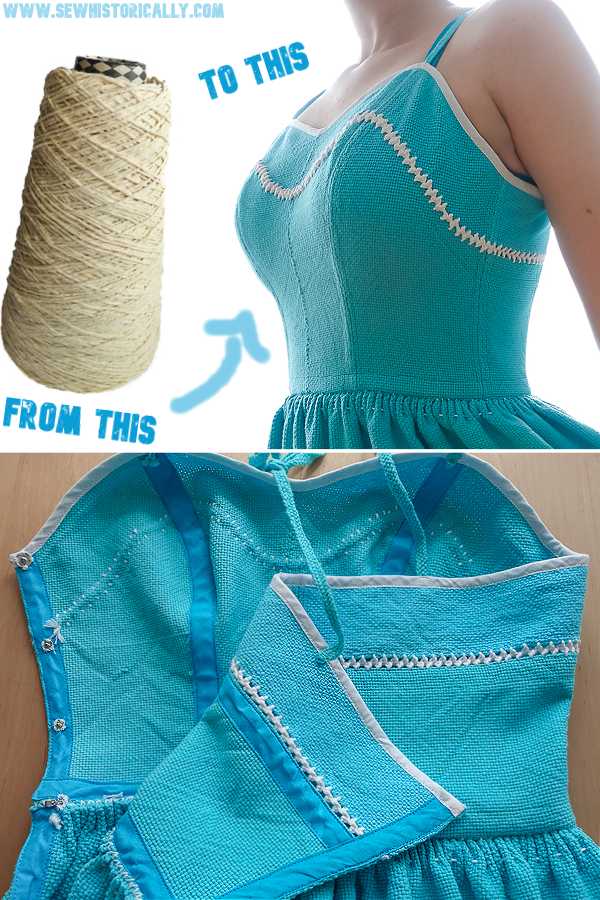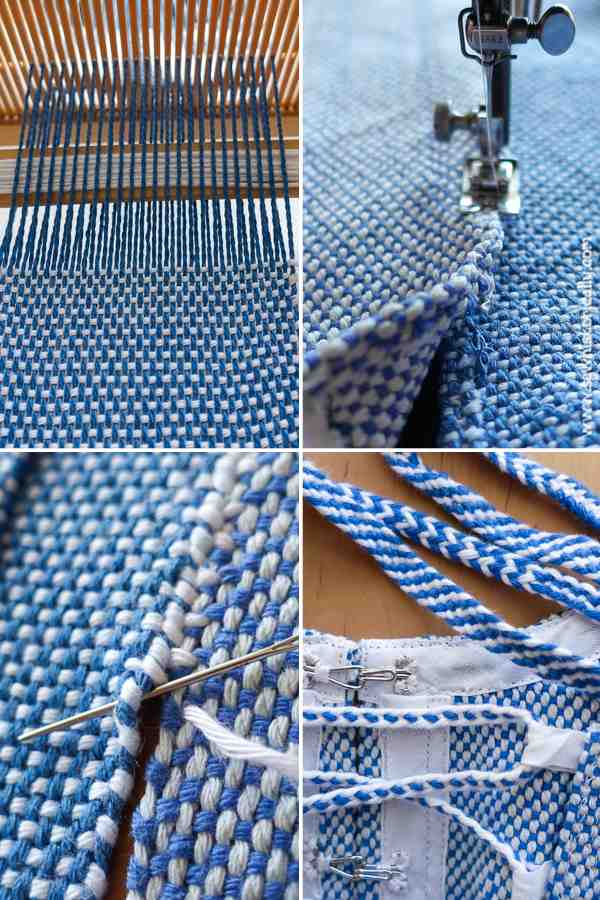Are you afraid to cut into your handwoven fabric? Here are 10 tried-and-true tips on how to sew handwoven fabric!
After making a handwoven dress, a handwoven corset top and handwoven 18th century stays, I learned some things along the way. 😀 These are my 10 tips on how to cut and sew handwoven fabric.
Don’t Be Afraid That Handwoven Fabric Frays Badly!
In fact, handwoven fabric doesn’t fray more than for example store-bought velvet fabric or loosely woven wool fabric. However, don’t handle handwoven fabric unnecessarily after cutting and before sewing. Because then handwoven fabric might fray – like any other fabric actually! 😉
Shrink Handwoven Fabric Before Sewing
As you should pre-wash all fabrics before sewing, it’s especially important to shrink handwoven fabric! To shrink your handwoven fabric, wash it in the washing machine on the setting you’ll later use to wash your finished garment. This is called fulling and hand-woven fabric shrinks considerably during the first wash. The fabric for my handwoven dress shrunk so much that I had to weave more fabric! 😉
What Sewing Pattern For Handwoven Fabrics?
You don’t have to choose a loose, baggy sewing pattern for your handwoven fabrics. You can use any sewing pattern for your handwoven fabrics: even a fitted pattern with darts and many seams like my handwoven 1950s-style fit-and-flare dress or my skin tight corset top.
Related: Handwoven Corset Top
Choose a garment where the natural stiffness of handwoven fabric is desirable like a corset top or a wide skirt.

Handwoven Fabric Can Stretch
Handwoven fabric is prone to stretching. And staystitching on curved or bias-cut edges can make it even worse and can stretch the piece out of shape! Also, don’t zigzag or serge the piece before or after cutting: this can also distort the piece.
So to prevent stretching of curved and bias-cut pieces, I found it worked best to just sew two pieces together with right sides together with closely spaced, straight stitches on my sewing machine.
Or you can sew a piece of narrow cotton ribbon to curved and bias-cut pieces to prevent stretching.
Seams Can Be Bulky
If you weave your own fabric on a rigid heddle loom or backstrap loom, the handwoven fabric is usually thicker than store-bought woven fabric. So you have to be careful that the seams don’t turn out too bulky.
Related: 34 Types of Seams
So when sewing handwoven fabric, make sure that there are as few layers of fabric in one seam as possible. Three layers – like in flat felled (or lapped) seams – can be too bulky and four layers – like in French seams – are definitely too bulky! 😉
On my handwoven corset top, I used flat felled seams. So there are three fabric layers in a seam. For a corset top it’s ok because the seams stiffen the garment so that you don’t have to add boning. But on a dress or skirt, flat felled seams are probably too bulky.
Flat, Tidy Seam For Handwoven Fabric
On my handwoven clothing, I always use a seam finish where all raw edges are encased in the seam. So there are no visible raw edges on the right or wrong side of the finished garment. This makes a strong and tidy seam and also prevents fraying when you wash and wear your handwoven clothes.
On my handwoven dress, I finished all seams with bias binding. With right sides together, I sewed the pattern pieces together with straight stitches. Then I pressed the seam open and finished the raw edges on the wrong side with bias tape. This makes a flat seam. Personally, I find this to be the best seam finish for handwoven fabric.

It’s Possible To Unpick Seams After A Mistake
If you made a mistake, it’s possible to unpick seams even on handwoven fabric. I “tried” it because I had to unpick seams on my handwoven dress after making a mistake! 😉 However, you should be more careful when unpicking a seam so that the piece doesn’t stretch out of shape.
Old German Stitch Aka Baseball Stitch
Traditionally, selvages of handwoven fabric were sewn together with the old German stitch. The old German stitch is like a closely spaced baseball stitch. You should use this stitch wherever possible to sew the selvages of your handwoven fabric together. The seam is flat and almost invisible on the finished garment! 😀
Shoulder Straps
To make shoulder straps for your handwoven dress or top, you can either make braided or woven shoulder straps. For my handwoven dress and handwoven corset top, I braided together 8 strands of the same cotton yarn that I also used for weaving.
Instead of braided straps, you can also weave a narrow piece of fabric for woven shoulder straps. To weave a narrow strip of fabric, it works especially well to use a small rigid heddle together with a backstrap loom. But you can also tablet weave the shoulder straps or use an inkle loom.
Weave Long, Narrow Pieces Of Fabric
After making some handwoven clothes, I find it better to weave longer and narrower pieces of fabric because you have less loom waste and less fabric waste. If you make fitted garment with seams, you have less fabric waste with narrow pieces of fabric. And if there’s just a small corner missing when you place your pattern on your handwoven fabric, you can attach a small piece of fabric with selvages together using the old German stitch.
Please Pin It!
